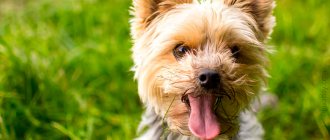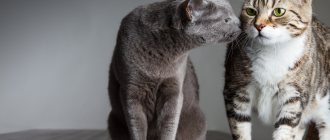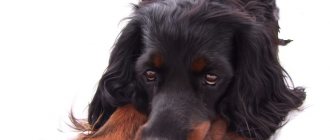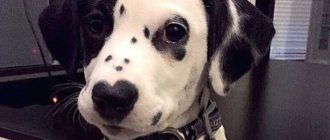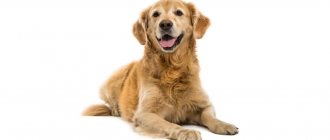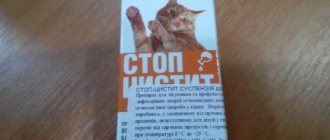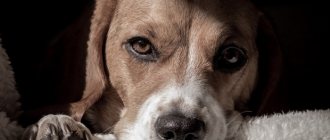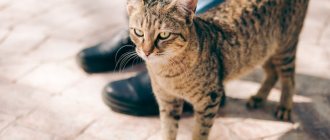Yorkshire Terriers are cute and unusual dogs. The breed was developed in the UK, they are considered a hunting breed, despite their one of the main problems of these dogs is their health.
They have long hair that grows throughout their lives and requires careful and frequent grooming.
The main problems are diseases of Yorkshire terriers: allergies, pancreatitis, problems of the musculoskeletal system, painful change of baby teeth, eye diseases and problems of the reproductive system (more often in Yorkie girls).
With good care and constant monitoring of the pet's health, these dogs can live 14 - 16 years . The weight of a terrier should not exceed 3 kg, and if the Yorkie is a mini, then 2 kg .
To provide your Yorkshire Terrier with a healthy and fulfilling life, you need to carefully weigh your options before you get a puppy.
Daily care of the Yorkshire Terrier
The dog needs to be carefully examined every day and in case of changes that raise questions for the owner or cause discomfort, at the first signs of Yorkie illness, you should immediately consult a doctor :
- Every morning, you need to wipe your Yorkie’s eyes from the accumulated secretions with a cotton pad dipped in warm water, chamomile infusion or a weak tea solution.
- The pet's ears are cleaned once a week - earwax is removed with a cotton swab.
- If the terrier has long hair, comb it daily with a slicker brush and a long-toothed metal comb to prevent tangles from forming and, if necessary, trim it. If the fur is short, then you can comb it with a massage brush.
- to bathe the dog once every 1.5 - 2 weeks in warm water. Use special shampoos suitable for this breed. The shampoo must be diluted in water, create foam and lather the dog from tail to head. Rinse off immediately, but from the head. After bathing, wrap the animal in a towel and lightly wring out the fur. Dry naturally or with a hairdryer, but warm, not hot!
- The dog's nose should be cold . The nose can only be hot and dry in the morning. There should be no snot or discharge from the nostrils.
- Yorkie's nails need to be trimmed 2-3 times a month by 2 mm . For this, a special guillotine-type nail clipper is used. Sold in pet stores. Available for different sizes of dogs.
- Inspect your pet's jaw daily for plaque or tartar . You need to buy a special toothpaste and a small toothbrush and brush your Yorkie's teeth 1-2 times a week. Or give special chewing bones to clean teeth from plaque.
What to do if your Yorkshire Terrier is constipated?
Constipation in a Yorkie can be an indication of both an incorrect diet (cheap food, poor drinking) and serious diseases of the gastrointestinal tract. If adjustments to the menu and daily routine do not solve the problem of constipation, you should urgently visit a veterinarian.
Features of walking a dog
The Yorkshire Terrier differs from other breeds in its coat, which does not cause allergies in humans, and the absence of undercoat , which does not allow them to walk without high-quality dog clothing in winter.
That is why this breed can be classified as a so-called indoor dog . Puppies are trained to use the tray from the first months of life.
When walking a terrier in winter, you need to wear overalls so that the pet does not freeze. In summer you can wear special cotton overalls.
Important! It is necessary to walk it on a tape measure with a collar; you cannot let it off the leash, since the bold and fearless Yorkie may be in danger if there is a road and cars nearby, or if it gets lost.
After a walk, your four-legged friend needs to be washed. If not completely, then be sure to wash the paws, belly and face.
Leather and wool
Have you noticed that your dog is starting to itch a lot? Subcutaneous ticks and fleas in the Yorkshire Terrier not only cause discomfort, causing severe itching, but can also be carriers of various infectious diseases.
Don't forget about helminth prevention. Worms are dangerous because they destroy the animal’s body from the inside. How can you tell if your dog has internal parasites? Lethargy, lack of appetite, constipation or diarrhea, pallor of the mucous membranes, tousled and coarse hair, dandruff, wounds on the skin - these are just the first signs that should attract the attention of the dog breeder. Deworming of the dog is carried out under the supervision of the attending veterinarian.
A healthy Yorkshire Terrier has a beautiful, soft coat. However, allergies, skin dermatitis, bacterial or fungal infections, insects, and even irritation after grooming can negatively affect a dog's appearance.
The most common genetic diseases of Yorkies
- Allergic reactions and dermatitis . They are expressed by the fact that the animal scratches itself, an increase in temperature occurs. An accurate diagnosis is made by a doctor, who also prescribes medications.
- The breed has a genetic predisposition to joint diseases .
- Dislocations in the area of the kneecap . Since the breed is very fragile, they should not be allowed to jump from high platforms.
- Inflammation of the pancreas. Symptoms are vomiting, refusal to eat, lethargy and weakness. Treatment is prescribed after an accurate diagnosis.
- Eye diseases . In case of excessive tears or, on the contrary, dryness, you need to consult a specialist.
Yorkie's musculoskeletal system
The fragile skeleton of this breed is susceptible to several diseases.
With congenital displacement of abnormally formed joints of the limbs, both one and both hind limbs can be affected.
This breed disorder is considered one of the most common today.
Patella luxation is a congenital condition in Yorkshire Terriers. Essentially, this is a sprain or eversion of a joint (violation of its position), sometimes accompanied by rupture of ligaments. May develop into osteoarthritis.
Despite the nature of this sore - hereditary - protect your dog from jumping and injury; Yorkies have very weak ligaments.
As sad as it is to admit, most modern Yorkies have a congenital median dislocation of the prominent lobes of the joints (the same patella).
In addition to dislocation, displacement or absence of protruding parts of the joints is not uncommon. The disease is divided into 4 degrees of severity.
Hereditary dislocation of the elbow , as a rule, occurs due to torn or stretched ligaments in the neighborhood. The outcome of the disease is the same as with dislocation of the calyx, only in relation to the forelimb.
Another breed problem is separation of the femoral head . With this diagnosis, the epiphysis spontaneously separates from the apophysis along the epiphyseal plate, which in turn is responsible for the development of the femur.
The main symptom: the dog is limping more and more intensely, and may not step on its paw at all. Another sign is that the Yorkie places the sore paw at an acute angle to the healthy one.
It is not uncommon for Yorkshire Terriers to suffer from separation of the head of the humerus. The same thing is observed, only for the forelimbs.
The causes of this disease are unknown. Possible causes include the dog’s misuse of vitamins and minerals.
Legg-Calvé-Perthes disease , or aseptic necrosis of the femoral head .
Yorkies under the age of one year are susceptible to it (mostly at 5-10 months), and manifests itself at 3-5 months.
Yes, Perthes has heredity, but the causes of this disease are completely unknown not only to veterinarians, but also to human doctors.
“Officially” - the blood supply to the bone tissue is disrupted, as a result of which it becomes dead and dissolves. That is, the bone of the head and neck of the femur is destroyed without an inflammatory process.
Symptoms are expected: pain when moving the hip away from the body, lameness, muscle atrophy. Surgical treatment is prescribed after x-rays of the hip joints.
Tendency to fractures . Seriously, it's innate in Yorkies.
They can break from things that other breeds are unlikely to break: a jump, a sprain, a minor fall.
Atlanto-axial instability sounds unclear and indicates pathological mobility between the 1st and 2nd cervical vertebrae of the Yorkshire Terrier.
The root of the evil is usually a congenital underdeveloped 2nd vertebra or ligamentous apparatus, rupture of ligaments due to injury or fracture of the vertebrae.
Any damage to the atlantoaxial joint puts pressure on the dog's spinal cord, causing neurological disorders: neck pain, decreased sensitivity, weakness of muscles and limbs, ataxia (discoordination).
The disease is diagnosed by cervical x-ray and neurological examination.
Impaired ossification of the frontal bones (in fact, non-overgrowth of the fontanel ). Soft area at the border of bony sutures in a newborn puppy. In rare cases, there may be several fontanelles.
In weakened babies, this tissue ossifies up to 7-10 months, in healthy ones - even faster. If the fontanel has not healed before a year, there is almost a 100% chance that it will remain soft forever.
Tracheal collapse is a sharp spasm of the pharynx , resulting in difficulty breathing and suffocation.
Almost all dwarf dogs suffer from this terrible disease. It occurs due to poorly developed (soft) cartilaginous half-rings of the pharynx.
The reasons for the latter are breed, young age, regular pressure collar, metabolic disorders.
What to do : do your best to protect your Yorkie’s delicate skeleton from damage; He's had enough of congenital problems with bones and cartilage. Do not allow your dog to jump from a height (even from your hands) or get injured at all, so as not to cause serious complications. And, of course, any situation requires a private approach: from medication to surgical treatment.
Vaccination of puppies
Vaccinations for Yorkies - puppies are usually given at the age of 1.5 - 2 months - it depends on when the puppy stopped feeding mother's milk. If it continues, then it is worth holding off on vaccination.
The second time is vaccinated after 2 or 4 weeks . And the third vaccination is given closer to the time when the Yorkie turns one year old and all the baby teeth are replaced.
Two weeks before vaccination, the pet is given anthelmintic drugs, and after vaccination it is not advisable to go out for a walk for 2 weeks or a month.
Adult terriers are vaccinated once a year.
Important! Vaccination is done only if the animal is completely healthy. If your pet is sick, postpone vaccination until complete recovery.
Actions in case of illness
We have no doubt that Yorkies are very active dogs full of enthusiasm. Like many purebred dogs, Yorkshire Terriers have a predisposition to developing certain disorders and health problems. Below in this article we will look at the most common diseases and tell you what to do.
Changing teeth in a Yorkshire Terrier
A puppy's baby teeth begin to change at 4 months. It is important to ensure that there is no growth of a new tooth on the baby tooth. The process of changing teeth ends at 10 months or a year.
Advice! It is important to examine your pet’s mouth every day, and if the gums are red or there is heavy plaque, go to the canine dentist.
What to do after removing tartar?
If your dog has tartar (its indicators are plaque on the teeth, inflammation of the gums, bad breath), then it must be removed . After this, the Yorkie's mouth is washed with antiseptics for 5 days .
It is recommended to visit a professional veterinary dentist at least once a year.
A veterinary dentist can professionally clean your pet's teeth (if necessary) and provide necessary advice on how to maintain canine oral hygiene.
Yorkie has diarrhea, what to do?
If a dog has diarrhea , then it is impossible to determine the causes on your own. You need to give the dog clean water and activated carbon (1/3 or ½ tablet, you can crush it).
Give only dry food, changing it every 5 hours. You can also drink strong tea.
But as soon as possible , take him to the veterinarian or call a doctor at home (if such a service is available).
Actions in case of vomiting
Vomiting in a Yorkie can be caused by overeating, poisoning or dangerous diseases. If your pet has overeaten or eaten too much fatty food, then keep him on a diet .
If vomiting does not stop within 24 hours, seek medical attention .
Important! Vomiting with foam is a dangerous situation that can be fatal. The animal must be taken to the veterinarian without delay.
Eye diseases
Owners often complain that their Yorkie's eyes are running .
This breed is susceptible to two types of eye disease - a lack of tears or an abundance of them .
It is worth paying special attention to your pet’s eyes - there should be no wet tracks or cloudy eyes.
Yorkie castration and care after surgery
Most often, problems arise in female Yorkies when they are in heat, but owners are in no hurry to get puppies.
Inflammation of the dog’s uterus and ovaries begins due to hormonal imbalance, which requires immediate surgical intervention.
After castration of the Yorkshire Terrier (sterilization), the animal should not be disturbed, but should be allowed to rest for 1.5 - 2 days.
Proper food, sleep and rest are the key to a quick recovery. To prevent the dog from scratching the stitches, a blanket is put on it.
Important! The animal should eat after it recovers from anesthesia. If the terrier does not eat within 24 hours after surgery, you should immediately consult a doctor.
Digestive system diseases
Quite common, varied in variety and associated with feeding errors. If a dog is overfed, obesity may occur, especially spayed and neutered animals. The first sign is excessive excess weight, which is bad for the heart. As a treatment, use a reduction in diet and exclusion of fatty foods.
A perverted appetite (a dog eating feces, stones, earth) can be a sign of serious diseases of the internal organs.
Errors in nutrition can also cause gastritis, which can be identified by symptoms: vomiting, weight loss, dull hair, and dandruff. If at least 2-3 signs are present, you should contact a veterinary clinic for treatment, since advanced forms can be fatal.
At home, it is enough to diagnose constipation - if the dog has problems with bowel movements: he whines, spins in one place, strains, but cannot recover. Constipation without proper attention can lead to serious consequences, since undigested food accumulates in the intestines and leads to rupture. If the animal's skin has acquired an unpleasant yellow tint, this may be a signal of liver disease; only a doctor can treat them.
Visiting a veterinarian
You should visit the veterinarian for a preventive examination 2 times a year.
After visiting a veterinarian, many pet owners are left with a lot of questions regarding their pet’s problem. Sometimes treatment failure is not due to the complexity of the case, but to a lack of information. To increase efficiency and avoid possible problems with incorrect treatment, we offer you a number of tips on how to properly use the services of a veterinarian.
Important! If you find that the animal is not feeling well and decide to take it to the clinic, take the time to remember carefully when and how it all started. Make a medical history. Along the way, try to provide the animal with maximum comfort, and most importantly, stress it as little as possible.
At the appointment, describe your animal’s condition before the disease in as much detail and as clearly as possible. After visiting your doctor, you should receive a clearly formulated preliminary diagnosis. It is better if the preliminary (or final) diagnosis, along with the prescriptions, are written down on paper, along with the name of the doctor who performed the examination.
Taking vitamins
Vitamins for Yorkies are prescribed after examination by a doctor and receipt of test results.
You should not engage in amateur activities and buy vitamins that your dog does not need.
It is worth noting that you should ask the breeder about genetic diseases to which the puppy is susceptible .
A healthy Yorkie is active and carefree.
Advice! If within 24 hours you observe a sharp change in behavior or see specific symptoms (discharge, refusal to eat), then you need to contact a veterinarian without independently diagnosing the dog and incompetent treatment.
Liver disease in Yorkies: what to do
Unfortunately, this is a consequence of the small size of the pet. His organs are vulnerable and react sharply to both deficiency and excess of various vitamins and microelements. An enlarged liver and portosystemic extrahepatic shunts are observed.
Danger of disease
Pathologically developed vessels disrupt the functioning of the organ, disrupting metabolism. Therefore, the pet suffers from deficiency and does not tolerate any poisoning well. Dwarf breeds are genetically susceptible.
Symptoms and treatment of extrahepatic shunt
Main features:
- liver failure;
- slow growth;
- vomit;
- convulsions;
- apathy.
During research, blood samples are taken. Treatment consists of installing a special constrictor, it directs blood through the liver, it is cleansed and the symptoms go away.
